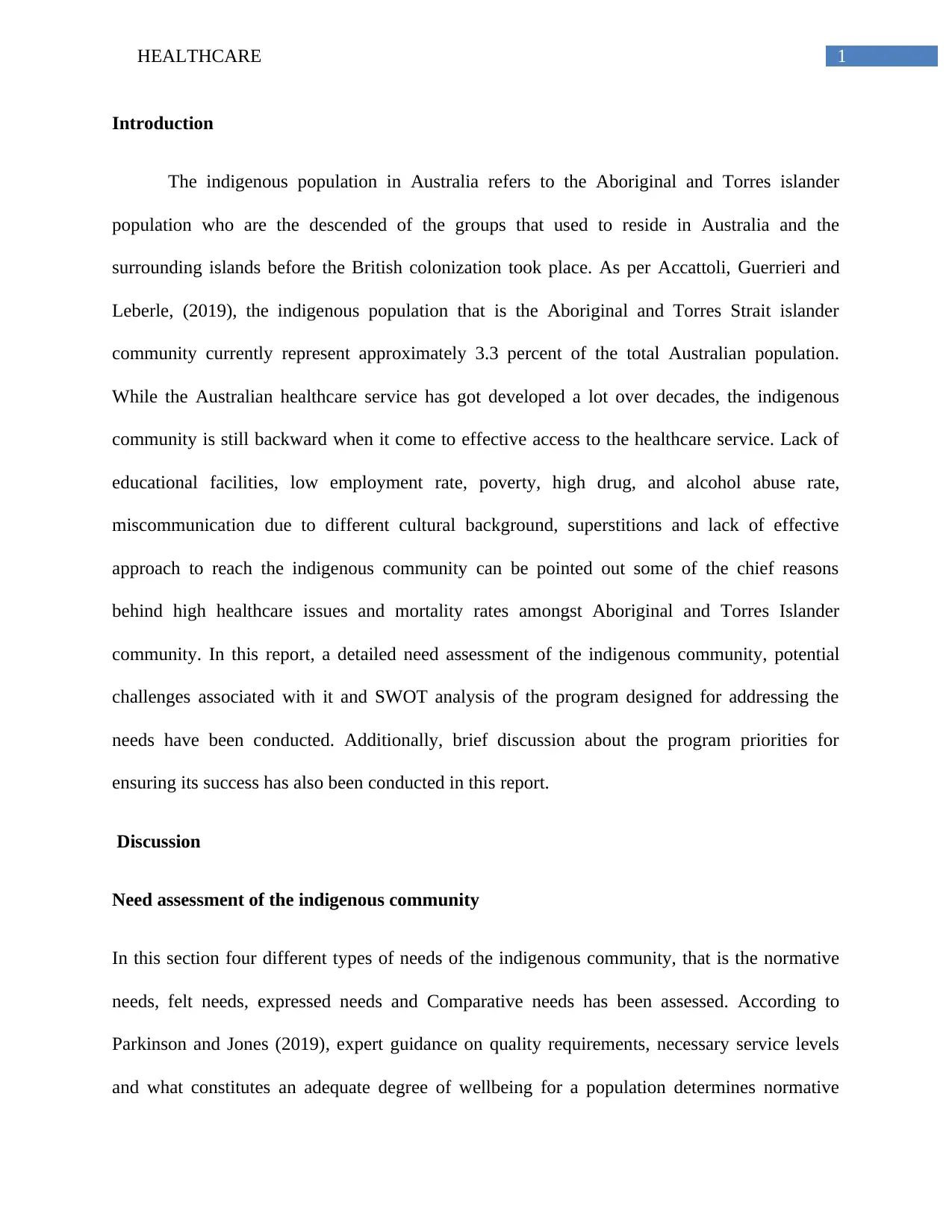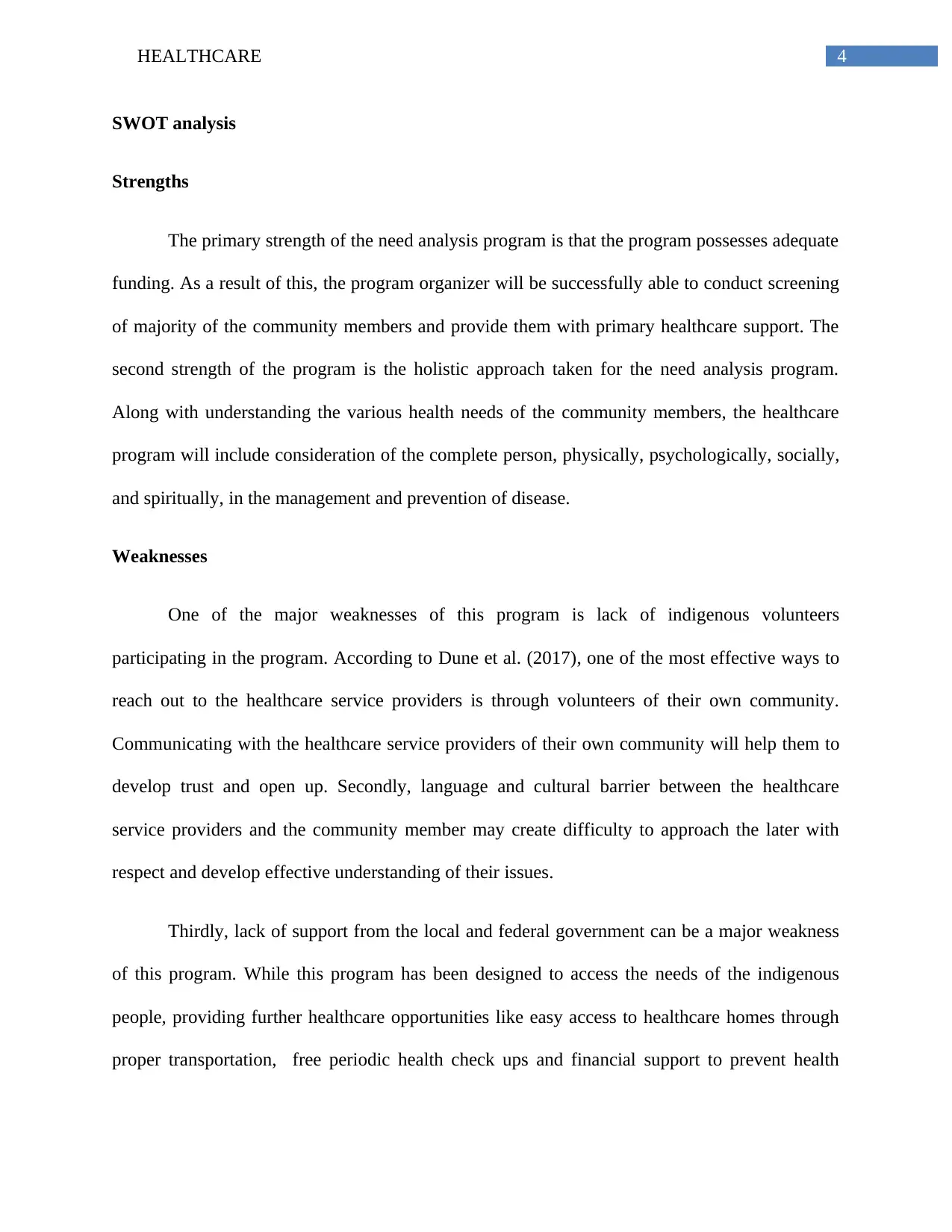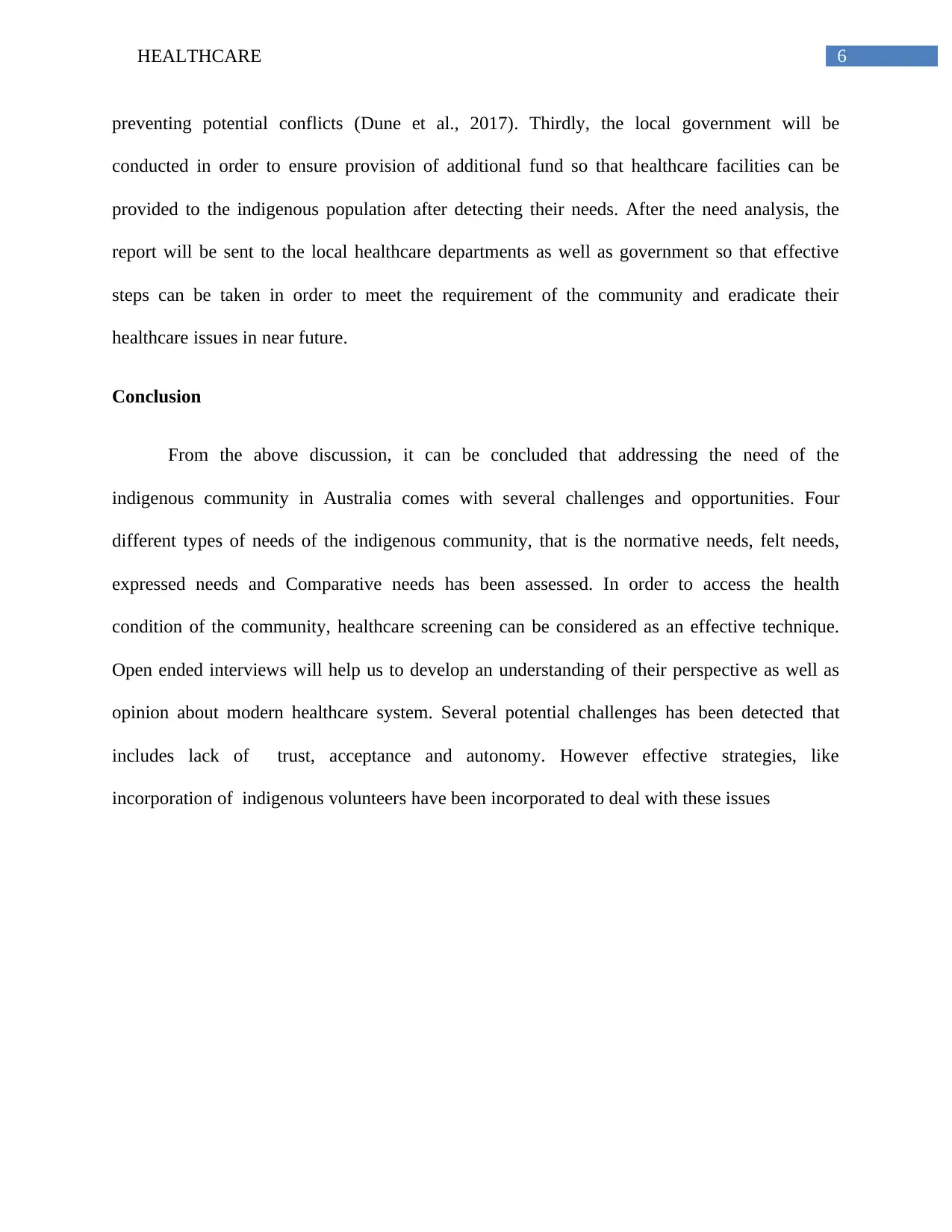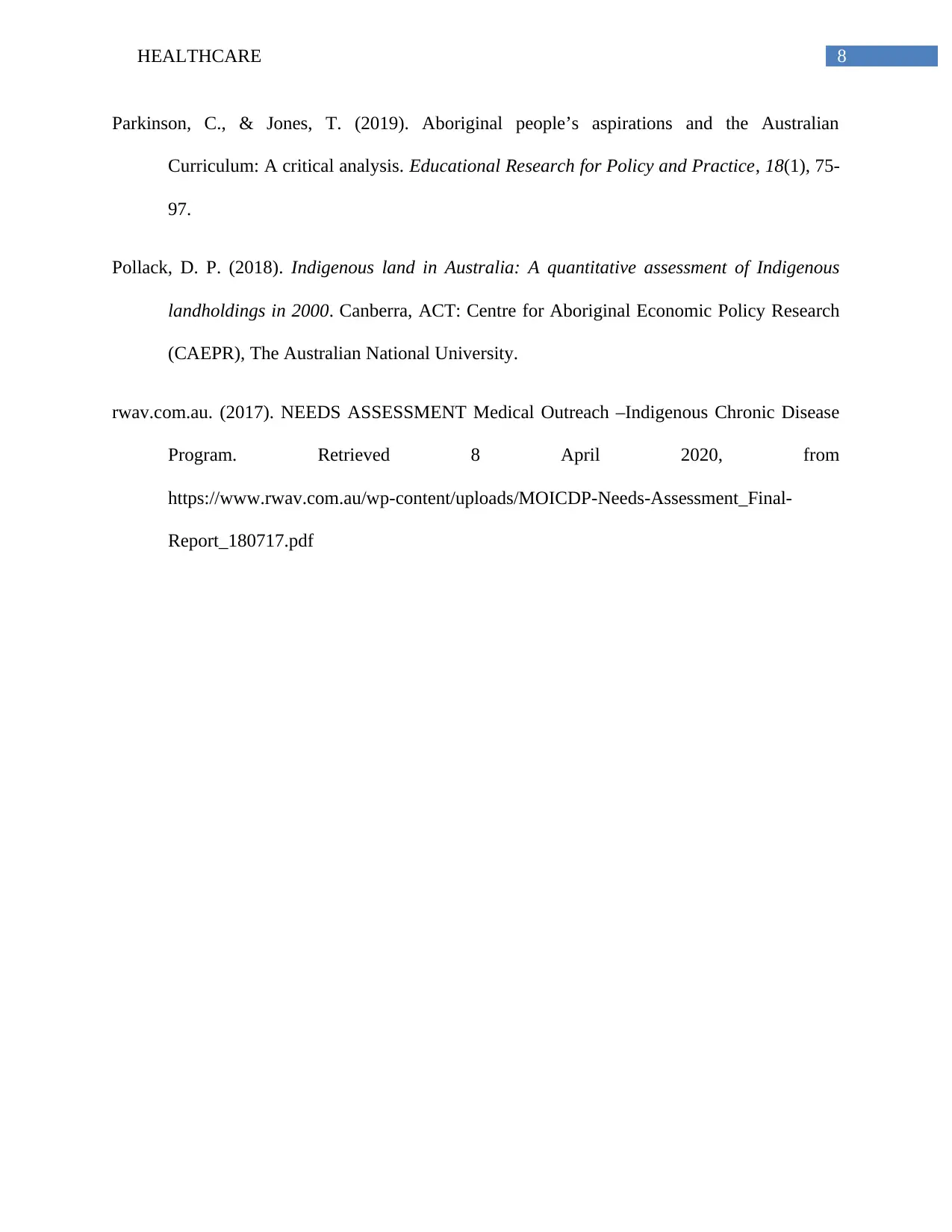Indigenous Population in Australia
VerifiedAdded on 2022/09/15
|9
|2096
|22
AI Summary
Contribute Materials
Your contribution can guide someone’s learning journey. Share your
documents today.

Running head: HEALTHCARE
Healthcare
Name of the Student
Name of the University
Author note
Healthcare
Name of the Student
Name of the University
Author note
Secure Best Marks with AI Grader
Need help grading? Try our AI Grader for instant feedback on your assignments.

1HEALTHCARE
Introduction
The indigenous population in Australia refers to the Aboriginal and Torres islander
population who are the descended of the groups that used to reside in Australia and the
surrounding islands before the British colonization took place. As per Accattoli, Guerrieri and
Leberle, (2019), the indigenous population that is the Aboriginal and Torres Strait islander
community currently represent approximately 3.3 percent of the total Australian population.
While the Australian healthcare service has got developed a lot over decades, the indigenous
community is still backward when it come to effective access to the healthcare service. Lack of
educational facilities, low employment rate, poverty, high drug, and alcohol abuse rate,
miscommunication due to different cultural background, superstitions and lack of effective
approach to reach the indigenous community can be pointed out some of the chief reasons
behind high healthcare issues and mortality rates amongst Aboriginal and Torres Islander
community. In this report, a detailed need assessment of the indigenous community, potential
challenges associated with it and SWOT analysis of the program designed for addressing the
needs have been conducted. Additionally, brief discussion about the program priorities for
ensuring its success has also been conducted in this report.
Discussion
Need assessment of the indigenous community
In this section four different types of needs of the indigenous community, that is the normative
needs, felt needs, expressed needs and Comparative needs has been assessed. According to
Parkinson and Jones (2019), expert guidance on quality requirements, necessary service levels
and what constitutes an adequate degree of wellbeing for a population determines normative
Introduction
The indigenous population in Australia refers to the Aboriginal and Torres islander
population who are the descended of the groups that used to reside in Australia and the
surrounding islands before the British colonization took place. As per Accattoli, Guerrieri and
Leberle, (2019), the indigenous population that is the Aboriginal and Torres Strait islander
community currently represent approximately 3.3 percent of the total Australian population.
While the Australian healthcare service has got developed a lot over decades, the indigenous
community is still backward when it come to effective access to the healthcare service. Lack of
educational facilities, low employment rate, poverty, high drug, and alcohol abuse rate,
miscommunication due to different cultural background, superstitions and lack of effective
approach to reach the indigenous community can be pointed out some of the chief reasons
behind high healthcare issues and mortality rates amongst Aboriginal and Torres Islander
community. In this report, a detailed need assessment of the indigenous community, potential
challenges associated with it and SWOT analysis of the program designed for addressing the
needs have been conducted. Additionally, brief discussion about the program priorities for
ensuring its success has also been conducted in this report.
Discussion
Need assessment of the indigenous community
In this section four different types of needs of the indigenous community, that is the normative
needs, felt needs, expressed needs and Comparative needs has been assessed. According to
Parkinson and Jones (2019), expert guidance on quality requirements, necessary service levels
and what constitutes an adequate degree of wellbeing for a population determines normative

2HEALTHCARE
need. One of the highly used normative assessment techniques used in healthcare includes health
screening. In order to access the health condition of the community, healthcare screening can be
considered as an effective technique. This will help the researchers to identify major heath issues
faced by the indigenous community. According to Altman and Daly (2018), for analyzing the felt
and expressed needs of indigenous community, it is highly crucial to communicate with them
and observe their life style and issues associated with it. According to rwav.com.au (2020),
cconducting consultation with the Aboriginal community-controlled health organisations can be
considered to be an effective way of understanding the needs and community.
Another optional method of need assessment includes conducting desktop search to
source the publicly available information. However, as per my opinion, using a mixed
methodology, that is undertaking secondary research for identifying geographic priority areas
that is areas with the prevalence of heath issues in the community should be followed by
consultation through campaigns. According to nsw.gov.au. (2015) interviewing through
development of questionnaire can be considered as one of the most effective need assessment
tools for Aboriginal and Torres islander community. While survey has been suggested by Pollack
(2018), as per my opinion, conducting face to face interview with the community members can
help us to detect the specific health care needs of the community members. Not only this, open
ended interviews will help us to develop an understanding of their perspective as well as opinion
about modern healthcare system. In order to analyze comparative needs, conducting interview
with the government and non government organizations who have already worked with the
community and conducting, along with conducting interview with the community members,
needs to be conducted.
need. One of the highly used normative assessment techniques used in healthcare includes health
screening. In order to access the health condition of the community, healthcare screening can be
considered as an effective technique. This will help the researchers to identify major heath issues
faced by the indigenous community. According to Altman and Daly (2018), for analyzing the felt
and expressed needs of indigenous community, it is highly crucial to communicate with them
and observe their life style and issues associated with it. According to rwav.com.au (2020),
cconducting consultation with the Aboriginal community-controlled health organisations can be
considered to be an effective way of understanding the needs and community.
Another optional method of need assessment includes conducting desktop search to
source the publicly available information. However, as per my opinion, using a mixed
methodology, that is undertaking secondary research for identifying geographic priority areas
that is areas with the prevalence of heath issues in the community should be followed by
consultation through campaigns. According to nsw.gov.au. (2015) interviewing through
development of questionnaire can be considered as one of the most effective need assessment
tools for Aboriginal and Torres islander community. While survey has been suggested by Pollack
(2018), as per my opinion, conducting face to face interview with the community members can
help us to detect the specific health care needs of the community members. Not only this, open
ended interviews will help us to develop an understanding of their perspective as well as opinion
about modern healthcare system. In order to analyze comparative needs, conducting interview
with the government and non government organizations who have already worked with the
community and conducting, along with conducting interview with the community members,
needs to be conducted.

3HEALTHCARE
For prioritize the findings, the major health issues faced by the community has been listed done.
Amongst the heath issues, the list has been topped by health care needs that have been found to
be affecting the highest percentage of the population, followed by the second highest and so on.
This method of prioritizing the findings will help the researchers to determine the healthcare
needs to be addressed first and on emergency basis.
Potential challenges associated with need assessment
Several potential challenges are there that can be faced by the researchers while
conducting the need analysis of the indigenous people. First of all, one of the major challenges
that can be faced while assessing the need of the indigenous community is lack of acceptance
due to cultural difference leading to mistrust (Lin et al. 2017). Considering the fact that the
cultural difference is huge amount the indigenous and non indigenous population in Australia,
and lack of effective bonding has also developed mistrust among several members of indigenous
population, the community members may not activity participate in the need analysis program.
In order to develop their trust the researchers will demonstrate effective cultural competence and
communicate with them, clearly stating the purpose of the campaign and why it is beneficial for
the community. Along with this, no pressurisation to participants or answer any questions will be
conducted (Jennings, Bond and Hill 2018). The second potential issue includes lack of
autonomy. Due to the cultural difference between respondents and interviewers, a clash of
autonomy may arise. For instance, in case the researcher wants to conduct a health screening,
members may refuse to visit the campaign tent for the purpose of the screening. In such cases,
the program organizer will communicate with the members, understand their needs and try to
incorporate strategies so that their autonomy can be maintained.
For prioritize the findings, the major health issues faced by the community has been listed done.
Amongst the heath issues, the list has been topped by health care needs that have been found to
be affecting the highest percentage of the population, followed by the second highest and so on.
This method of prioritizing the findings will help the researchers to determine the healthcare
needs to be addressed first and on emergency basis.
Potential challenges associated with need assessment
Several potential challenges are there that can be faced by the researchers while
conducting the need analysis of the indigenous people. First of all, one of the major challenges
that can be faced while assessing the need of the indigenous community is lack of acceptance
due to cultural difference leading to mistrust (Lin et al. 2017). Considering the fact that the
cultural difference is huge amount the indigenous and non indigenous population in Australia,
and lack of effective bonding has also developed mistrust among several members of indigenous
population, the community members may not activity participate in the need analysis program.
In order to develop their trust the researchers will demonstrate effective cultural competence and
communicate with them, clearly stating the purpose of the campaign and why it is beneficial for
the community. Along with this, no pressurisation to participants or answer any questions will be
conducted (Jennings, Bond and Hill 2018). The second potential issue includes lack of
autonomy. Due to the cultural difference between respondents and interviewers, a clash of
autonomy may arise. For instance, in case the researcher wants to conduct a health screening,
members may refuse to visit the campaign tent for the purpose of the screening. In such cases,
the program organizer will communicate with the members, understand their needs and try to
incorporate strategies so that their autonomy can be maintained.
Secure Best Marks with AI Grader
Need help grading? Try our AI Grader for instant feedback on your assignments.

4HEALTHCARE
SWOT analysis
Strengths
The primary strength of the need analysis program is that the program possesses adequate
funding. As a result of this, the program organizer will be successfully able to conduct screening
of majority of the community members and provide them with primary healthcare support. The
second strength of the program is the holistic approach taken for the need analysis program.
Along with understanding the various health needs of the community members, the healthcare
program will include consideration of the complete person, physically, psychologically, socially,
and spiritually, in the management and prevention of disease.
Weaknesses
One of the major weaknesses of this program is lack of indigenous volunteers
participating in the program. According to Dune et al. (2017), one of the most effective ways to
reach out to the healthcare service providers is through volunteers of their own community.
Communicating with the healthcare service providers of their own community will help them to
develop trust and open up. Secondly, language and cultural barrier between the healthcare
service providers and the community member may create difficulty to approach the later with
respect and develop effective understanding of their issues.
Thirdly, lack of support from the local and federal government can be a major weakness
of this program. While this program has been designed to access the needs of the indigenous
people, providing further healthcare opportunities like easy access to healthcare homes through
proper transportation, free periodic health check ups and financial support to prevent health
SWOT analysis
Strengths
The primary strength of the need analysis program is that the program possesses adequate
funding. As a result of this, the program organizer will be successfully able to conduct screening
of majority of the community members and provide them with primary healthcare support. The
second strength of the program is the holistic approach taken for the need analysis program.
Along with understanding the various health needs of the community members, the healthcare
program will include consideration of the complete person, physically, psychologically, socially,
and spiritually, in the management and prevention of disease.
Weaknesses
One of the major weaknesses of this program is lack of indigenous volunteers
participating in the program. According to Dune et al. (2017), one of the most effective ways to
reach out to the healthcare service providers is through volunteers of their own community.
Communicating with the healthcare service providers of their own community will help them to
develop trust and open up. Secondly, language and cultural barrier between the healthcare
service providers and the community member may create difficulty to approach the later with
respect and develop effective understanding of their issues.
Thirdly, lack of support from the local and federal government can be a major weakness
of this program. While this program has been designed to access the needs of the indigenous
people, providing further healthcare opportunities like easy access to healthcare homes through
proper transportation, free periodic health check ups and financial support to prevent health

5HEALTHCARE
issues, like financial support for enhanced sanitation, education and job employment from the
side of the government, is lacking.
Opportunities
The chief opportunity of this program is to include more indigenous healthcare volunteers
in the program. This can be done by providing them with a basic rumination. Incorporating
indigenous volunteers in the program will enhance the opportunity to have more access to the
community members (Jennings, Bond & Hill, 2018). Along with this, they will also be able to
teach the non indigenous population about their norms and culture so that effective cultural
competence can be developed within all the volunteers.
Threats
The primary threat of this program includes lack of acceptance of the community
members which may create a difficulty to gather information for the need analysis. The second
potential threat includes conflict due to cultural difference between the healthcare service
provider and users.
Program priorities
The first step that needs to be taken in order to ensure a successful need analysis program
is to enhance the cultural competencies of the volunteers. For this effective education about the
culture and norms of the indigenous community will be provided prior to the campaign.
Secondly, incorporation of volunteers from the indigenous population will be conducted in order
to ensure a diverse workforce. Not only this, indigenous volunteer will be able to understand the
issues in a more appropriate way and ensure autonomy of the community members along with
issues, like financial support for enhanced sanitation, education and job employment from the
side of the government, is lacking.
Opportunities
The chief opportunity of this program is to include more indigenous healthcare volunteers
in the program. This can be done by providing them with a basic rumination. Incorporating
indigenous volunteers in the program will enhance the opportunity to have more access to the
community members (Jennings, Bond & Hill, 2018). Along with this, they will also be able to
teach the non indigenous population about their norms and culture so that effective cultural
competence can be developed within all the volunteers.
Threats
The primary threat of this program includes lack of acceptance of the community
members which may create a difficulty to gather information for the need analysis. The second
potential threat includes conflict due to cultural difference between the healthcare service
provider and users.
Program priorities
The first step that needs to be taken in order to ensure a successful need analysis program
is to enhance the cultural competencies of the volunteers. For this effective education about the
culture and norms of the indigenous community will be provided prior to the campaign.
Secondly, incorporation of volunteers from the indigenous population will be conducted in order
to ensure a diverse workforce. Not only this, indigenous volunteer will be able to understand the
issues in a more appropriate way and ensure autonomy of the community members along with

6HEALTHCARE
preventing potential conflicts (Dune et al., 2017). Thirdly, the local government will be
conducted in order to ensure provision of additional fund so that healthcare facilities can be
provided to the indigenous population after detecting their needs. After the need analysis, the
report will be sent to the local healthcare departments as well as government so that effective
steps can be taken in order to meet the requirement of the community and eradicate their
healthcare issues in near future.
Conclusion
From the above discussion, it can be concluded that addressing the need of the
indigenous community in Australia comes with several challenges and opportunities. Four
different types of needs of the indigenous community, that is the normative needs, felt needs,
expressed needs and Comparative needs has been assessed. In order to access the health
condition of the community, healthcare screening can be considered as an effective technique.
Open ended interviews will help us to develop an understanding of their perspective as well as
opinion about modern healthcare system. Several potential challenges has been detected that
includes lack of trust, acceptance and autonomy. However effective strategies, like
incorporation of indigenous volunteers have been incorporated to deal with these issues
preventing potential conflicts (Dune et al., 2017). Thirdly, the local government will be
conducted in order to ensure provision of additional fund so that healthcare facilities can be
provided to the indigenous population after detecting their needs. After the need analysis, the
report will be sent to the local healthcare departments as well as government so that effective
steps can be taken in order to meet the requirement of the community and eradicate their
healthcare issues in near future.
Conclusion
From the above discussion, it can be concluded that addressing the need of the
indigenous community in Australia comes with several challenges and opportunities. Four
different types of needs of the indigenous community, that is the normative needs, felt needs,
expressed needs and Comparative needs has been assessed. In order to access the health
condition of the community, healthcare screening can be considered as an effective technique.
Open ended interviews will help us to develop an understanding of their perspective as well as
opinion about modern healthcare system. Several potential challenges has been detected that
includes lack of trust, acceptance and autonomy. However effective strategies, like
incorporation of indigenous volunteers have been incorporated to deal with these issues
Paraphrase This Document
Need a fresh take? Get an instant paraphrase of this document with our AI Paraphraser

7HEALTHCARE
References
Accattoli, B., Guerrieri, G., & Leberle, M. (2019, April). Types by need. In European
Symposium on Programming (pp. 410-439). Springer, Cham.
Altman, J., & Daly, A. E. (2018). Do fluctuations in the Australian macroeconomy influence
Aboriginal employment status?. Canberra, ACT: Centre for Aboriginal Economic Policy
Research (CAEPR), The Australian National University.
Dune, T., Perz, J., Mengesha, Z., & Ayika, D. (2017). Culture Clash? Investigating constructions
of sexual and reproductive health from the perspective of 1.5 generation migrants in
Australia using Q methodology. Reproductive health, 14(1), 50.
Jennings, W., Bond, C., & Hill, P. S. (2018). The power of talk and power in talk: a systematic
review of Indigenous narratives of culturally safe healthcare communication. Australian
Journal of Primary Health, 24(2), 109-115.
Lin, I. B., Ryder, K., Coffin, J., Green, C., Dalgety, E., Scott, B., ... & O’Sullivan, P. B. (2017).
Addressing disparities in low back pain care by developing culturally appropriate
information for aboriginal australians:“My Back on Track, My Future”. Pain Medicine,
18(11), 2070-2080.
nsw.gov.au. (2015). Aboriginal Health Service Needs Analysis. Retrieved 8 April 2020, from
https://www.nslhd.health.nsw.gov.au/Services/Directory/Documents/Aboriginal
%20Health%20Service%20Needs%20Analysis.pdf
References
Accattoli, B., Guerrieri, G., & Leberle, M. (2019, April). Types by need. In European
Symposium on Programming (pp. 410-439). Springer, Cham.
Altman, J., & Daly, A. E. (2018). Do fluctuations in the Australian macroeconomy influence
Aboriginal employment status?. Canberra, ACT: Centre for Aboriginal Economic Policy
Research (CAEPR), The Australian National University.
Dune, T., Perz, J., Mengesha, Z., & Ayika, D. (2017). Culture Clash? Investigating constructions
of sexual and reproductive health from the perspective of 1.5 generation migrants in
Australia using Q methodology. Reproductive health, 14(1), 50.
Jennings, W., Bond, C., & Hill, P. S. (2018). The power of talk and power in talk: a systematic
review of Indigenous narratives of culturally safe healthcare communication. Australian
Journal of Primary Health, 24(2), 109-115.
Lin, I. B., Ryder, K., Coffin, J., Green, C., Dalgety, E., Scott, B., ... & O’Sullivan, P. B. (2017).
Addressing disparities in low back pain care by developing culturally appropriate
information for aboriginal australians:“My Back on Track, My Future”. Pain Medicine,
18(11), 2070-2080.
nsw.gov.au. (2015). Aboriginal Health Service Needs Analysis. Retrieved 8 April 2020, from
https://www.nslhd.health.nsw.gov.au/Services/Directory/Documents/Aboriginal
%20Health%20Service%20Needs%20Analysis.pdf

8HEALTHCARE
Parkinson, C., & Jones, T. (2019). Aboriginal people’s aspirations and the Australian
Curriculum: A critical analysis. Educational Research for Policy and Practice, 18(1), 75-
97.
Pollack, D. P. (2018). Indigenous land in Australia: A quantitative assessment of Indigenous
landholdings in 2000. Canberra, ACT: Centre for Aboriginal Economic Policy Research
(CAEPR), The Australian National University.
rwav.com.au. (2017). NEEDS ASSESSMENT Medical Outreach –Indigenous Chronic Disease
Program. Retrieved 8 April 2020, from
https://www.rwav.com.au/wp-content/uploads/MOICDP-Needs-Assessment_Final-
Report_180717.pdf
Parkinson, C., & Jones, T. (2019). Aboriginal people’s aspirations and the Australian
Curriculum: A critical analysis. Educational Research for Policy and Practice, 18(1), 75-
97.
Pollack, D. P. (2018). Indigenous land in Australia: A quantitative assessment of Indigenous
landholdings in 2000. Canberra, ACT: Centre for Aboriginal Economic Policy Research
(CAEPR), The Australian National University.
rwav.com.au. (2017). NEEDS ASSESSMENT Medical Outreach –Indigenous Chronic Disease
Program. Retrieved 8 April 2020, from
https://www.rwav.com.au/wp-content/uploads/MOICDP-Needs-Assessment_Final-
Report_180717.pdf
1 out of 9
Related Documents
Your All-in-One AI-Powered Toolkit for Academic Success.
+13062052269
info@desklib.com
Available 24*7 on WhatsApp / Email
![[object Object]](/_next/static/media/star-bottom.7253800d.svg)
Unlock your academic potential
© 2024 | Zucol Services PVT LTD | All rights reserved.




